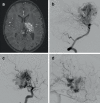Adenosine-induced Asystole during AVM Embolization : A Case Series
- PMID: 34125253
- PMCID: PMC8894166
- DOI: 10.1007/s00062-021-01035-z
Adenosine-induced Asystole during AVM Embolization : A Case Series
Abstract
Background: Adenosine induced cardiac standstill has been used intraoperatively for both aneurysm and arteriovenous malformation (AVM) surgery and embolization. We sought to report the results of adenosine induced cardiac standstill as an adjunct to endovascular embolization of brain AVMs.
Material and methods: We retrospectively identified patients in our prospectively maintained database to identify all patients since January 2007 in whom adenosine was used to induce cardiac standstill during the embolization of a brain AVM. We recorded demographic data, clinical presentation, Spetzler Martin grade, rupture status, therapeutic intervention and number of embolization sessions, angiographic and clinical results, clinical and radiological outcomes and follow-up information.
Results: We identified 47 patients (22 female, 47%) with average age 42 ± 17 years (range 6-77 years) who had undergone AVM embolization procedures using adjunctive circulatory standstill with adenosine. In total there were 4 Spetzler Martin grade 1 (9%), 9 grade 2 (18%), 15 grade 3 (32%), 8 grade 4 (18%), and 11 grade 5 (23%) lesions. Of the AVMs six were ruptured or had previously ruptured. The average number of embolization procedures per patient was 5.7 ± 7.6 (range 1-37) with an average of 2.6 ± 2.2 (range 1-14) embolization procedures using adenosine. Overall morbidity was 17% (n = 8/47) and mortality 2.1% (n = 1/47), with permanent morbidity seen in 10.6% (n = 5/47) postembolization. Angiographic follow-up was available for 32 patients with no residual shunt seen in 26 (81%) and residual shunts seen in 6 patients (19%). The angiographic follow-up is still pending in 14 patients. At last follow-up 93.5% of patients were mRS ≤2 (n = 43/46).
Conclusion: Adenosine induced cardiac standstill represents a viable treatment strategy in high flow AVMs or AV shunts that carries a low risk of mortality and permanent neurological deficits.
Keywords: AVM; Adenosine; Asystole; Embolization; Resection.
© 2021. The Author(s).
Conflict of interest statement
P. Bhogal: consultant for phenox, MIVI neurosciences, Balt, serves on advisory board for Cerenovus. M. Aguilar Pérez: proctor and consultant for phenox. H. Henkes: co-founder of phenox. V. Hellstern, M. Alfter, A. Kemmling, E. Henkes and O. Ganslandt declare that they have no competing interests.
Figures



References
-
- Pile-Spellman J, Young WL, Joshi S, Duong H, Vang MC, Hartmann A, Kahn RA, Rubin DA, Prestigiacomo CJ, Ostapkovich ND. Adenosine-induced cardiac pause for endovascular embolization of cerebral arteriovenous malformations: technical case report. Neurosurgery. 1999;44:881–886. doi: 10.1097/00006123-199904000-00117. - DOI - PubMed
-
- Bebawy JF, Zeeni C, Sharma S, Kim ES, DeWood MS, Hemmer LB, Ramaiah VK, Bendok BR, Koht A, Gupta DK. Adenosine-induced flow arrest to facilitate intracranial aneurysm clip ligation does not worsen neurologic outcome. Anesth Analg. 2013;117:1205–1210. doi: 10.1213/ANE.0b013e3182a6d31b. - DOI - PubMed
-
- Benech CA, Perez R, Faccani G, Trompeo AC, Cavallo S, Beninati S, Berardino M. Adenosine-induced cardiac arrest in complex cerebral aneurysms surgery: an Italian single-center experience. J Neurosurg Sci. 2014;58:87–94. - PubMed
MeSH terms
Substances
LinkOut - more resources
Full Text Sources
Medical

